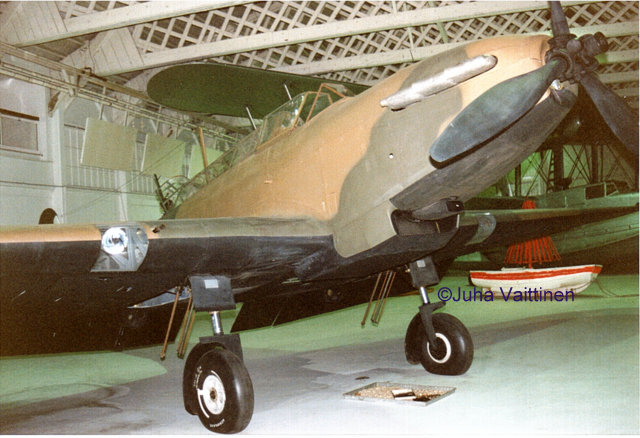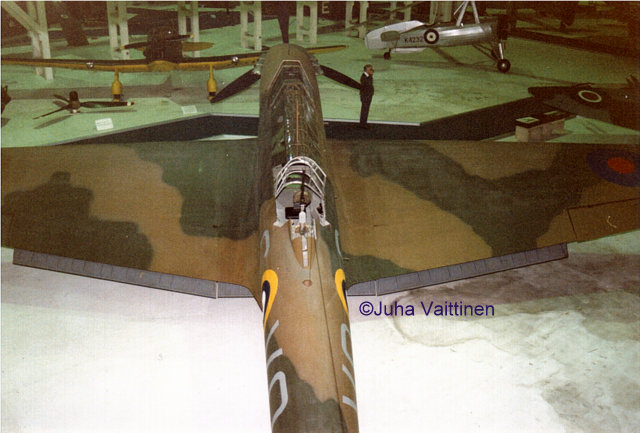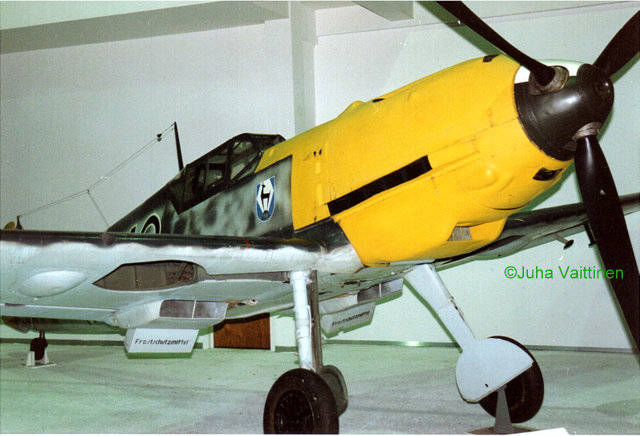The first aerial victory of a British pilot/gunner during the WW II.
The first RAF kills, unfortunately own goals:
6 September 1939
The Battle of Barking Creek, Spitfires of ”A” Flight of 74 Sqn, flown by Flying Officer Vincent Byrne and Pilot Officer John Freeborn, shot down a Hurricane of 56 Sqn (Pilot Officer Montague Leslie Hulton-Harrop KIA) and hit another in the cooling system so badly that P/O Frank C. Rose, unhurt, had to make a forced landing in a sugar beet field. Rose’s plane (L1980) was repaired and returned to combat service. The Court Martial acquitted both Byrne and Freeborn of any liability or blame. The reasons for the tragedy were technical malfunction of the CH radar station at Canewdon aggravated by failings of the control network and errors by the controllers.
The first confirmed RAF kill, later found unfounded:
20 September 1939
Sgt F.A. Letchford, the observer in the Fairey Battle piloted by Flying Officer Baker (K9243) of No. 88 Squadron, claimed the first RAF victory of the war. He claimed a German Bf 109 during a patrol near Aachen. The claim was later confirmed by French troops. There were in fact no LW losses. The three Battles of No. 88 Squadron had been attacked by three Bf 109Ds of JGr 152, which shot down two of the Battles. The victors were Hauptmann Lessmann and Oberleutnant Wiggers.
The first true British air combat victory
26th September 1939
The first Luftwaffe aircraft shot down by a British aircraft. A Dornier Do18D flying boat (W.Nr. 0731) of 2./Küstenfliegergruppe 506 was forced down North of the Great Fisher Bank by Lieutenant B. S. McEwen and his air gunner Acting Petty Officer B. M. Seymour flying a Blackburn Skua of No. 803 Squadron, Fleet Air Arm, operating from the aircraft carrier HMS Ark Royal. Lt. zur See Ernst Körner and his crew were rescued by the destroyer HMS Somali, which then sank the aircraft K6+YK with gunfire. Even if the Do 18D is said to have belonged to Küstenfliegergruppe 506 its identification code was that of Küstenfliegergruppe 406, namely K6+.
The first RAF kill
27th September 1939
The victim was a Messerschmitt Bf109D-1 from JGr. 152. It was shot down by return fire during an attack on three No. 103 Squadron Battles by four Bf109D-1s from JGr.152 west of Hornbach and crashed near Bockweiler at 1230 hrs. Gefreiter or Obergefreiter (sources differ on his rank) Josef Scherm was killed, the aircraft was a write off. The victor was Leading Aircraftman (LAC) John Ernest Summers in Fiying Officer A.L. Vipan’s K9271. The Bf 109s had attacked just as the Battles had completed their mission to take oblique photographs along the Siegfried Line and turned for home. LAC Summers had held his fire until the Bf 109 attacking his Battle had closed right in before giving it a burst from his Vickers GO gun, whereupon the 109 had fallen into a wood. The observer of his plane, Sergeant J.H. Vickers, was badly wounded and died of his wound on 7 Oct. The pilot F/O Vipan had to make a forced landing onto a field with failing engine. However K9271 wasn’t badly damaged and the other two Battles returned unscathed. LAC Summers was later awarded the Distinguished Flying Medal.
Sources, among others
Andy Saunders’ Fighter Command’s first casualty - in The Blitz Then and Now Volume 1 editor Winston G. Ramsey (1987).
The Blitz Then and Now Volume 1 editor Winston G. Ramsey (1987).
Victor Bingham’s Blitzed! (1990).
Norman Franks’ Valiant Wings (1994).
Francis K. Mason's The British Bomber since 1914 (1994).
Shores et al: Fledgling Eagles (1991).
Anthony G. Williams' & Dr. Emmanuel Gustin's Flying Guns World War II (2003).
Michael Apps’ The Four Ark Royals (1976) pp. 112-113.
William Jameson’s ARK ROYAL The Life of an Aircraft Carrier at War (2004) p.29.
Ray Sturtivant's BRITISH NAVAL AVIATION Fleet Air Arm, 1917 - 1990 (1990) p. 33.
6 September 1939
The Battle of Barking Creek, Spitfires of ”A” Flight of 74 Sqn, flown by Flying Officer Vincent Byrne and Pilot Officer John Freeborn, shot down a Hurricane of 56 Sqn (Pilot Officer Montague Leslie Hulton-Harrop KIA) and hit another in the cooling system so badly that P/O Frank C. Rose, unhurt, had to make a forced landing in a sugar beet field. Rose’s plane (L1980) was repaired and returned to combat service. The Court Martial acquitted both Byrne and Freeborn of any liability or blame. The reasons for the tragedy were technical malfunction of the CH radar station at Canewdon aggravated by failings of the control network and errors by the controllers.
The first confirmed RAF kill, later found unfounded:
20 September 1939
Sgt F.A. Letchford, the observer in the Fairey Battle piloted by Flying Officer Baker (K9243) of No. 88 Squadron, claimed the first RAF victory of the war. He claimed a German Bf 109 during a patrol near Aachen. The claim was later confirmed by French troops. There were in fact no LW losses. The three Battles of No. 88 Squadron had been attacked by three Bf 109Ds of JGr 152, which shot down two of the Battles. The victors were Hauptmann Lessmann and Oberleutnant Wiggers.
The first true British air combat victory
26th September 1939
The first Luftwaffe aircraft shot down by a British aircraft. A Dornier Do18D flying boat (W.Nr. 0731) of 2./Küstenfliegergruppe 506 was forced down North of the Great Fisher Bank by Lieutenant B. S. McEwen and his air gunner Acting Petty Officer B. M. Seymour flying a Blackburn Skua of No. 803 Squadron, Fleet Air Arm, operating from the aircraft carrier HMS Ark Royal. Lt. zur See Ernst Körner and his crew were rescued by the destroyer HMS Somali, which then sank the aircraft K6+YK with gunfire. Even if the Do 18D is said to have belonged to Küstenfliegergruppe 506 its identification code was that of Küstenfliegergruppe 406, namely K6+.
The first RAF kill
27th September 1939
The victim was a Messerschmitt Bf109D-1 from JGr. 152. It was shot down by return fire during an attack on three No. 103 Squadron Battles by four Bf109D-1s from JGr.152 west of Hornbach and crashed near Bockweiler at 1230 hrs. Gefreiter or Obergefreiter (sources differ on his rank) Josef Scherm was killed, the aircraft was a write off. The victor was Leading Aircraftman (LAC) John Ernest Summers in Fiying Officer A.L. Vipan’s K9271. The Bf 109s had attacked just as the Battles had completed their mission to take oblique photographs along the Siegfried Line and turned for home. LAC Summers had held his fire until the Bf 109 attacking his Battle had closed right in before giving it a burst from his Vickers GO gun, whereupon the 109 had fallen into a wood. The observer of his plane, Sergeant J.H. Vickers, was badly wounded and died of his wound on 7 Oct. The pilot F/O Vipan had to make a forced landing onto a field with failing engine. However K9271 wasn’t badly damaged and the other two Battles returned unscathed. LAC Summers was later awarded the Distinguished Flying Medal.
Sources, among others
Andy Saunders’ Fighter Command’s first casualty - in The Blitz Then and Now Volume 1 editor Winston G. Ramsey (1987).
The Blitz Then and Now Volume 1 editor Winston G. Ramsey (1987).
Victor Bingham’s Blitzed! (1990).
Norman Franks’ Valiant Wings (1994).
Francis K. Mason's The British Bomber since 1914 (1994).
Shores et al: Fledgling Eagles (1991).
Anthony G. Williams' & Dr. Emmanuel Gustin's Flying Guns World War II (2003).
Michael Apps’ The Four Ark Royals (1976) pp. 112-113.
William Jameson’s ARK ROYAL The Life of an Aircraft Carrier at War (2004) p.29.
Ray Sturtivant's BRITISH NAVAL AVIATION Fleet Air Arm, 1917 - 1990 (1990) p. 33.



